Seoul searching
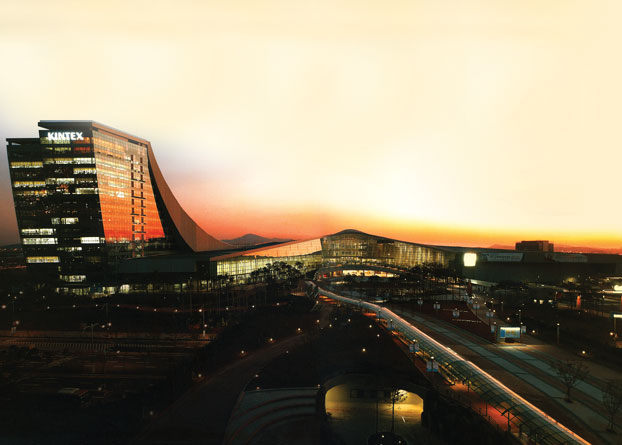
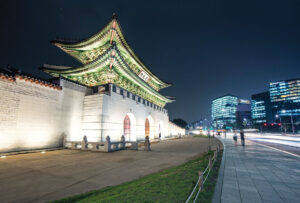
The Republic of Korea is home to about 50 million people, half of whom
live in and around Seoul, the world’s second most populous city. Mountains cover 70 percent of the country, making space precious, and most new buildings tall. This geography informs the entire nation: its commitment to concision, its mindfulness about making the most of its resources, and its dedication to recycling and effective ecological practices. It might also explain why Koreans are wild about hiking.
Walk around downtown Seoul and you see industrious, serious men and 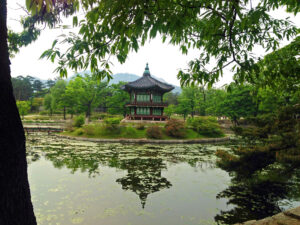 women going off to work. You see fit, fashion-forward young people with the smartest of smart phones. You see a world-class city that has taken its place as an economic powerhouse, a centre of technological
women going off to work. You see fit, fashion-forward young people with the smartest of smart phones. You see a world-class city that has taken its place as an economic powerhouse, a centre of technological
innovation, and the cultural nexus of Asia. In 2016, you can see all of Seoul for yourself when it hosts the Rotary International Convention from 28 May to 1 June.
The city is divided by the Han River. Government, banking and investment offices occupy an area known as the Manhattan of Korea. North of the river is old Seoul; to the south, Gangnam (gang, meaning “river,” and nam, “south”) is the emergent cultural centre of the city, 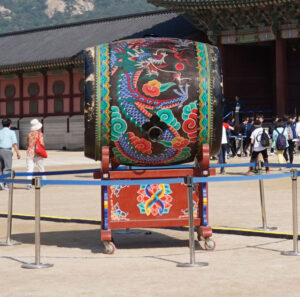 where the rents are high, the kids are cool, and everything is happening. Gangnam has its own style; perhaps you’ve heard.
where the rents are high, the kids are cool, and everything is happening. Gangnam has its own style; perhaps you’ve heard.
The Iconic Palace
You owe yourself a guided tour of Seoul. Gyeongbok Palace alone deserves several hours. It was the seat of power for Taejo, the first king
of the Joseon Dynasty (1392–1910). During full-dress ceremonial occasions, ministers stood in careful order, next to stone markers indicating rank. The king could identify, by placement, who represented what interest at what level. Slightly uneven stone pavers on the path leading to the throne forced all who approached the king to watch where they stepped, and therefore to come with heads bowed.
Within the grounds of the palace, the beautifully designed and informative
Korean Fol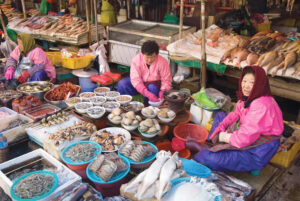 k Museum showcases the artifacts and customs of everyday life. An ingenious invention of summer bedding is the
k Museum showcases the artifacts and customs of everyday life. An ingenious invention of summer bedding is the
jukbuin, which translates to “bamboo wife” — a large woven bamboo cylinder across which a sleeper can drape himself for maximum ventilation.
Cheonggyecheon, an inspired urban renewal project completed in 2005, rerouted traffic and brought to life a stream that runs through the centre of Seoul. It is now a refreshing promenade that serves as an oasis for office workers during the day and the romantically inclined 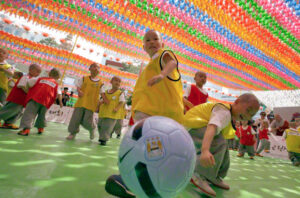 during the evening. Stroll along the wide walkways on either side; at intervals, stepping stones allow you to cross over.
during the evening. Stroll along the wide walkways on either side; at intervals, stepping stones allow you to cross over.
Insa-dong, which looks like a village that survived Seoul’s transition into a post-modern city, is a neighborhood filled with antique dealers, art galleries, and restaurants. The winding streets lead past specialty shops where you can find Goryeo celadon and other ceramics, and traditional furniture such as antique Korean chests. You’ll also see tea houses offering time-honoured herbal brews, which often include ginseng and ginger. Side streets climb a hill to reveal centuries-old private homes. The atmosphere is hushed; signs (in English) ask visitors to keep their voices down.
Desi dining
In Korea, dining is a team sport. Plates big and small occupy every available inch of the table; pick and choose among them with your stainless steel chopsticks, transferring food to the plate in front of you. There will be kimchi — always kimchi. The national dish is served at every meal. Sample everything. Someone will politely indicate which items may be too spicy for Western palates.
The 2016 Rotary International Convention, 28 May–1 June, will take place at the KINTEX centre, about an hour outside Seoul. Rotary will occupy both behemoth buildings, which are outfitted with the latest technology. It is a beautiful and spacious setting. Organisers are planning a series of events and tours before, during, and after the convention. Many of the sites mentioned here will be included. Visit www.riconvention.org for specifics, and to register.
Napkins are small, the size of cocktail napkins. Considering that so much of the food is handheld, one of these doesn’t last long; don’t be shy about asking for more. In many restaurants, tables have a buzzer that will summon your server. When something needs to be cut — such as gogigui, or Korean barbecue — servers use oversize scissors rather than a knife and fork. Gogigui comes in several forms, but the best known is marinated beef.
A refrain of my visit was, “Try this. It’s good for your health.” On a hot day, you may be encouraged to eat samgyetang, a ginseng soup that contains a whole young chicken and is considered exceptionally nourishing. Teas made of scorched rice, cinnamon, pine buds, or corn bestow specific healthful attributes. Ask a Korean woman what makes her skin so flawless, and she might say, “I eat a lot of mushrooms.” Street food is delicious; for the adventurous, try a bowl of beondegi — silkworm pupae served hot. (Sauce is optional.)
Starbucks galore
Korea has a strong tea culture, but it runs on coffee. Seoul is home to more Starbucks than any other city in the world. In 2014, the Ministry of Agriculture, Food and Rural Affairs announced that coffee is more popular in Korea than kimchi — quite a feat in a country where families have traditionally gathered each fall to prepare large quantities of the spicy pickled dish, which is fermented in a crock and buried in the ground to maintain the required temperature. Some contemporary apartment dwellers use specially designed refrigerators.
Beyond Seoul, about two hours on a high-speed train will bring you to Gyeongju, the ancient capital of the Silla Dynasty (668–935) and part of the Silk Road. The comfortable bullet train zips through the mountainous landscape in a serene whoosh of efficiency and spotlessness.
The vast Bulguksa Temple is Korea’s most famous. One of the oldest surviving Buddhist temples — built during the reign of King Beopheung (514–540) and later rebuilt during and after the reign of King Gyeongdeok (742–765) — is a masterpiece of Silla architecture. Nestled on a hillside among groomed stands of pine and fruit trees, its intricately fitted, mortar-free stone steps and arches lead to vast terraces. Grand stone staircases usher the visitor up to awe-inspiring halls and pagodas. An experienced guide is essential.
Kim Daesong, the architect who worked on the Bulguksa Temple, also had a hand in building the Seokguram Grotto, considered one of Korea’s finest Buddhist shrines. A gentle incline brings you to a broad terrace dominated by a huge structure framing a carved grotto. Surrounded by bodhisattvas and guardian deities, a serene Buddha gazes out over tree-covered hills and the East Sea to the distant horizon.
Nearby, the large rolling hills of the Daereungwon Tomb Complex look at first glance like an especially cruel golf course. But visit the tomb, excavated in 1973, for a fascinating insight into the fifth- and sixth-century sensibility. Also take in the Cheomseongdae Observatory, the oldest in Asia, and the Gyeongju National Museum, an impor- tant anthology of relics and artifacts.
Peep into history
Throughout its history, Korea has had an uneasy relationship with its neighbours. It has been invaded, warred upon, occupied, its people enslaved, its cultural treasures forcibly exported for decoration elsewhere. It has enjoyed periods of calm and prosperity, but it rests with one eye open. And now it shares a border to the north with one of the world’s most bewildering, belligerent dictators. This neighbour has a huge standing army, a clumsy but worrisome nuclear capability, and an oppressed populace.
One of the starkest places to visit is the DMZ — the demilitarised zone that separates North and South Korea. An hour outside Seoul and once the site of fierce warfare, it is a heavily guarded border. In some areas, it’s also a nature preserve; in others, the fertile land yields specially labelled and highly prized rice, ginseng and wine. Diverse plant and animal life thrives, oblivious to political bellowing and boundaries. It’s a metaphor for the optimistic spirit of South Koreans. Resolutions and wishes for peace can be found throughout the country, even on ribbons fluttering from the barbed wire along the border with North Korea.
Panmunjom houses the Joint Security Area, a surreal collection of buildings on both sides of the Military Demarcation Line. That line runs right though the conference room for joint talks, dividing even the conference table itself. An air of contained tension prevails at the checkpoint, with security forces from both sides radiating intense alertness.
Of particular interest to me was the Third Infiltration Tunnel, one of four discovered since the cease-fire in 1953. This one, found in 1978 based on intelligence from a defector who escaped from the North, was designed to deliver into South Korea 30,000 troops in full battle gear every hour. It’s claustrophobia- inducing with 40 or 50 fellow tourists down there; 30,000 soldiers marching through at the same time would require impressive discipline. I ended up against a walled-up dead end within 170 metres of the North Korean border.
On the ride to and from the DMZ, barbed-wire-topped fences and observation posts line the Imjin River. On the South Korean side, trees grow lushly up the mountainsides. On the North Korean side, the mountains are bare, the trees having been cut down for firewood.
Farther afield, the port city of Busan is a centre for shipping, and for cosmetic surgery. It also hosts a beach resort and has a fascinating fish market, Jagalchi, where, down long aisles of aerated tanks, you can see crowded, lively seafood. The octopus tanks seethe with undulations, and the long-limbed crabs are intent on escaping their containers. Women proudly adorned in pink run the market; out of necessity, they took over when men went off to war. These Jagalchi ajumma remain the face of the operation.
Beomeosa Temple, at the edge of Mount Geumjeongsan, was constructed during the Silla Dynasty. Renovated in 1713, it features vibrant colors and some of the most delicate and luxurious architectures of the Joseon Dynasty. There’s a three-story pagoda, built in the ninth century, seven royal palace wings, three gates, and 11 hermitages. As the chief temple of the Jogye Order of Korean Buddhism, monks still live there. On the day I visited, a lavish celebration involving hundreds of monks from all over Korea honoured Dongsan — a monk revered for refusing to submit to the Japanese occupiers before World War II who sought to dilute the rigour of Korean Buddhism by allowing monks to marry, as they do in Japan. This is one of the temples where visitors may stay and join in the monks’ routine.
Closer to the East Sea, the path that winds through Dongbaek Park offers great views of the forested hillside and of the Nurimaru APEC (Asia-Pacific Economic Cooperation) house, which hosted the 2005 APEC conference. Follow the stairway and it deposits you on the magnificent Haeundae Beach, fringed with luxury high-rise hotels.
If you’re unable to participate in the tours the Host Organisation Committee has arranged, conclude your visit at the Korean Folk Village, a short distance from Seoul, which cleverly showcases the customs and skills found in a typical village. You can see a traditional marriage ceremony, marvel at the simple but painful methods of punishment in the jail, and visit shops to see pottery and other crafts in action.
Korea is a country without lassitude. It’s filled with people who aim to be healthy, successful and happy, and who want to share this with visitors. They are proud of their country and what they’ve been able to achieve despite tremendous challenges. They get down to business — and that business has, in all its forms, flourished. Their children are curious and exuberant with optimism. As a visitor from the United States, I was a curiosity, as was anyone with blond hair. They practice saying hello in English, and want to have their picture taken with visitors as proof that our worlds overlap. As proof that something special is happening, and that all of us are part of it.
Reproduced from The Rotarian
